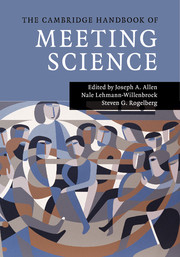Book contents
- The Cambridge Handbook of Meeting Science
- The Cambridge Handbook of Meeting Science
- Copyright page
- Dedication
- Contents
- Tables
- Figures
- Contributors
- Book part
- Part I Introduction
- Part II Premeeting Activities and Context
- Part III The Meeting Itself
- Capturing and Understanding Dynamics and Processes of the Meeting
- Tools and Models for Promoting Meeting Success
- 21 Designing and Executing Effective Meetings with Codified Best Facilitation Practices
- 22 Finding the Gorilla
- 23 Information Utilization in Meetings
- 24 What Is Consensus and How Is It Achieved in Meetings?
- 25 Creativity and Meetings
- Part IV Special Types of Meetings
- Part V Synthesis and Conclusion
- Book part
- Author Index
- Subject Index
- References
21 - Designing and Executing Effective Meetings with Codified Best Facilitation Practices
from Tools and Models for Promoting Meeting Success
Published online by Cambridge University Press: 05 August 2015
- The Cambridge Handbook of Meeting Science
- The Cambridge Handbook of Meeting Science
- Copyright page
- Dedication
- Contents
- Tables
- Figures
- Contributors
- Book part
- Part I Introduction
- Part II Premeeting Activities and Context
- Part III The Meeting Itself
- Capturing and Understanding Dynamics and Processes of the Meeting
- Tools and Models for Promoting Meeting Success
- 21 Designing and Executing Effective Meetings with Codified Best Facilitation Practices
- 22 Finding the Gorilla
- 23 Information Utilization in Meetings
- 24 What Is Consensus and How Is It Achieved in Meetings?
- 25 Creativity and Meetings
- Part IV Special Types of Meetings
- Part V Synthesis and Conclusion
- Book part
- Author Index
- Subject Index
- References
Summary
Collaboration is a ubiquitous phenomenon in organizations that often takes place in the setting of a meeting. Organizations use meetings as a focal point to bring people together to collaborate, coordinate, plan, or accomplish some result. This chapter focuses on a specific type of meeting: co-creation meetings, where teams collaborate to produce tangible deliverables. The chapter begins with a discussion of co-creation meetings and the role of facilitation in leading groups in these settings. We then introduce two key concepts to support facilitators. First, patterns of collaboration are the building blocks of the collaboration process in a co-creation meeting. Second, the ThinkLets pattern language represents a collection of codified packets of facilitation skills to achieve predictable, repeatable patterns of collaboration. ThinkLets can be used as a form of collaboration Lego to design and execute co-creation meetings. To illustrate the applicability of ThinkLets, we present a case study with the American Telehealth Association (ATA). We discuss our use of ThinkLets in the design of four collaborative writing workshops, specifically, meeting process design, results, and participant perceptions. We conclude with an examination of the broader applications of ThinkLets, including other types of co-creation meetings, some limitations of the work presented here, and directions for future research.
- Type
- Chapter
- Information
- The Cambridge Handbook of Meeting Science , pp. 483 - 503Publisher: Cambridge University PressPrint publication year: 2015
References
- 5
- Cited by

